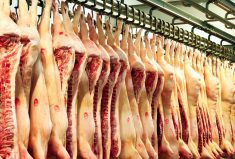Pop stars may sneer that “beef stinks,” but beef is still on the menu in 96 per cent of Canadian households and for 93 per cent of individuals, the Beef Information Centre says.
“That compares fairly closely with chicken, which scored 98 per cent on households and 97 on an individual basis,” said Beef Information Centre executive director of consumer operations Ron Glaser in a presentation based on BIC’s latest consumer research at the semi-annual convention of the Canadian Cattlemen’s Association.
Pork is less popular scoring only in the high 80s for both criteria.
Read Also

Mazergroup’s Bob Mazer dies
Mazergroup’s Bob Mazer, who helped grow his family’s company into a string of farm equipment dealerships and the main dealer for New Holland machinery in Saskatchewan and Manitoba, died July 6 from cancer.
“That gives you a sense that the consumer hasn’t abandoned our product or animal products in general.”
Those who seek to reduce or eliminate animal products from their diet, make up just six per cent of all Canadians.
Of that percentage, just 4.5 per cent are “flexitarians,” which means they still have some animal-based foods in their diet. Vegetarians make up only 1.3 per cent of the population, and hard-core true vegans, who eat only plant products, are just 0.5 per cent.
MINUSCULE
“That’s really a minuscule number of Canadians and those numbers have been very consistent and stable over the past number of years,” said Glaser.
“Is that surprising? When you watch the popular media, you can sometimes think that the whole world is against you. So, you can take some comfort in that.”
The vegetarian minority is generally 20 to 39 years old, largely urban and male. In Glaser’s opinion, the phenomenon is nothing more than youth challenging established morality – a stance that fades with age and experience.
“Beef consumption actually increases once people hit that 30-to 40-years-of-age range, when they become parents and have families. Diets tend to move more towards the mainstream,” he added.
“Meatless Mondays” may get a lot of electrons on the Internet, but only 23 per cent of adults have even heard of the campaign hatched by activists who assert that animal agriculture is a major cause of greenhouse gas emissions and must be reduced to save the planet.
SMALL UPTAKE
Only six per cent of Canadians are participating, he added.
“That strikes me as funny, because that’s the same six per cent who weren’t eating beef in the first place,” said Glaser. “These aren’t new converts.”
Research shows that health concerns are the No. 1 drag on beef consumption, followed by food safety fears related to hormone and antibiotic residues.
Organic “means good things” in the minds of consumers, but they are willing to pay only a five per cent premium for organic beef.
The gains seen for other consumer products haven’t boosted organic beef’s fortunes as much, but Glaser believes that having it available as an alternative is positive overall for the industry because it means that more beef will be sold.
NUTRITION
When asked what was paramount in deciding whether to buy beef out of a list of four concerns, 70 per cent of respondents ranked “healthfulness” as the top one or two, “safety” 64 per cent, “animal welfare” 28 per cent, and the “environmental impact of beef production” was tops for 22 per cent.
“Overwhelmingly, it’s about health and nutrition. Productionrelated issues such as animal welfare and the environment are not the primary concern,” said Glaser.
Fat and cholesterol are the top worries. In terms of food safety, 18 per cent mentioned “mad cow disease,” and 14 per cent feared hormones and antibiotics, and nine per cent worried about E. coli, listeria, or salmonella.
Only 23 per cent of respondents mentioned animal welfare concerns, but of that number, 35 per cent expressed concern about how animals are treated in the process of raising cattle, and 28 per cent specifically raised concerns about their treatment at slaughter.
“They start mentioning factory farms, unfortunately, but we know that there is a marked difference in perception of conventional cow-calf operations to intensive operations,” he said. “The consumers see them very differently.”
But when comparing concerns about livestock production for various species, 30 per cent thought beef was better than the others, while 30 per cent thought it was worse.
———
“Isthatsurprising?When youwatchthepopular media,youcansometimes thinkthatthewholeworld isagainstyou.So,youcan takesomecomfortinthat.”
– RON GLASER


















